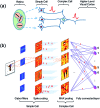Computing of temporal information in spiking neural networks with ReRAM synapses
- PMID: 30361729
- PMCID: PMC6390697
- DOI: 10.1039/c8fd00097b
Computing of temporal information in spiking neural networks with ReRAM synapses
Abstract
Resistive switching random-access memory (ReRAM) is a two-terminal device based on ion migration to induce resistance switching between a high resistance state (HRS) and a low resistance state (LRS). ReRAM is considered one of the most promising technologies for artificial synapses in brain-inspired neuromorphic computing systems. However, there is still a lack of general understanding about how to develop such a gestalt system to imitate and compete with the brain's functionality and efficiency. Spiking neural networks (SNNs) are well suited to describe the complex spatiotemporal processing inside the brain, where the energy efficiency of computation mostly relies on the spike carrying information about both space (which neuron fires) and time (when a neuron fires). This work addresses the methodology and implementation of a neuromorphic SNN system to compute the temporal information among neural spikes using ReRAM synapses capable of spike-timing dependent plasticity (STDP). The learning and recognition of spatiotemporal spike sequences are experimentally demonstrated. Our simulation study shows that it is possible to construct a multi-layer spatiotemporal computing network. Spatiotemporal computing also enables learning and detection of the trace of moving objects and mimicking of the hierarchy structure of the biological visual cortex adopting temporal-coding for fast recognition.
Figures











References
-
- LeCun Y., Bengio Y., Hinton G. Nature. 2015;521:436–444. - PubMed
-
- Shulaker M. M., Hills G., Park R. S., Howe R. T., Saraswat K., Wong P., Mitra S. Nature. 2017;547:74–78. - PubMed
-
- Merolla P. A., V Arthur J., Alvarez-icaza R., Cassidy A. S., Sawada J., Akopyan F., Jackson B. L., Imam N., Guo C., Nakamura Y., Brezzo B., Vo I., Esser S. K., Appuswamy R., Taba B., Amir A., Flickner M. D., Risk W. P., Manohar R., Modha D. S. Science. 2014;345:668–673. - PubMed
-
- Yang J. J., Strukov D. B., Stewart D. R. Nat. Nanotechnol. 2013;8:13–24. - PubMed
Publication types
MeSH terms
LinkOut - more resources
Full Text Sources

